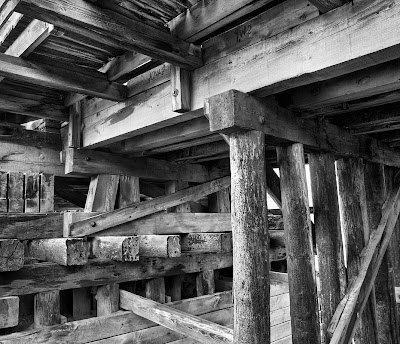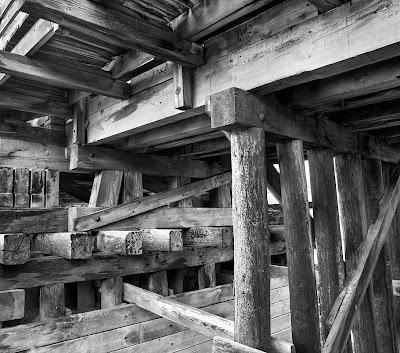

Rather like those drawings in he newspaper which ask kids to spot the differences between two almost identical drawings, the two images above are the latest version (I hate to say final, since I don't know what I might do to the image next week), and below it what I had previously thought of as the final image. See what you can make of the changes and what you think of them. Don't forget you can click on the images to open the image in a separate window, much larger and easier to inspect.
Michael Reichmann in a comment about workflow mentions that sometimes he needs to work on an image in Photoshop. As Lighrtoom has no local controls other than spotting, the implication is that often he doesn't need to 'work on' his images. The other day I was talking with Uwe Steinmuller of OutbackPhoto and he mentioned that I did a lot more work or local editing on my images than he did.
It's true that I probably don't have any images that haven't had some 'work' applied to an image. I mean by this that rather than applying global changes to curves, levels, colour balance, hue/intensity or whatever, I have used masks to apply these effects locally (thus the need for Photoshop). My normal practice is to make dozens of changes to an image, and sometimes hundreds, over several weeks and many hours.
This isn't all that different from my work in the wet darkroom in which I used recipes for burning as recommended by the late Fred Picker, so that I could repeat the recipe or modify it in the next print. These recipes quite often had six or more steps to the making of a print.
Now that effects can be made much more precicely and repetitively over smaller areas of the print, I make even more adjustments. That these effects are transparent to the viewer indicates that with practice (ok, lots of practice) I have learned not to go over the top (most of the time).
The image above is one I worked on for several weeks and thought I had it right, but one minor thing bugged me (the upper left looked dodged), so I brought the image back into Photoshop and made that correction, then looked at the whole image and noticed a number of other flaws. The white beam on the left edge (1/3 from the bottom) seemed rather glaring. Rather than burn it down I decided I could get away with a crop. Then I decided that the diagonal beam on the bottom of the image (middle) was spoiled by the second plank, and that this too could be cropped to make a tidier image. Then I noticed a hot spot in the other diagonal beam running from middle bottom to middle right side, so I darkened the hot spot (it was real but didn't look it, so it had to go). I decided that the vertical posts in the bottom right of the picture weren't quite bold enoough, so a bit more work was done in this area. A couple of the really light parts of wood seemed glaring, so I darkened them - in all I probably made another 20 changes to the image, one which had already had close to 100 changes made already. I'm guessing that by end I had created and subsequently flattened around 30 layers, each masked and the effects applied to various parts of the image.
You might think I'm crazy to put that much effort into an image and perhaps you are right, but as one of the things I am known for is the quality of my prints, I have to think that this has been important to me and to my work.
One could, of course; reject all images which are less than perfect, but I'd cut down my good images to less than a 10th if I did that - I for one can't afford to throw away that much good material and would probably have become so discouraged by my photography I'd have quit (again).
If you are someone who doesn't do much local work on your images, you might want to live with an image for a few days, then decide what further changes you could add. This cycle could then be repeated. Will you go overboard and spoil an image - sure - I have lots of images which went way past ideal. That's why the image above is labelled version 2 - I can always go back to the first version. There are times I have saved up to 7 versions of an image, knowing that there were so many changes between each version that undoing wasn't possible. I also sometimes use 'snapshot' in the history palette to record a spot I'm at, but generally prefer to save the file, avoid risk of losing it if the computer crashes or there's a power failure, and keep the image I'm working on from getting too huge.
Seem like way too much work? Think of it this way - you probably have 20 - 30 images which are your best work and by which you are known, or by which you represent yourself - aren't those images worth this much effort?



6 comments:
The top image jumped out at me immediately, and I couldn't have told you much of what was different apart from the shadows being richer. But that doesn't mean you can't appreciate that a lot of work has gone into it. I'd love to see it in print.
I've found recently that a lot of my peers have abandoned photoshop in favour of lightroom because they see photoshop as overkill, and prefer to stick with the global changes that lightroom allows. But 90% of my photoshop work involves layers and masks so I feel crippled without it. Does that mean I produce weaker images out of the camera? Possibly. But I'm in this for the joy of doing as much as the end result - if not more, considering the lack of prints hanging on my wall!
I hope you continue to enjoy working on your images, and the rest of us can enjoy the results...
I'm not sure i've ever gone as far as that, but I certainly do quite a lot of local adjustment. On my best work (big prints for the wall) I also track several versions.
This is one reason why I switched to Lightzone - lots of powerful tools, far easier to do (& modify) local adjustments than PS (IMO) and small save files.
When I feel one is ready for a print, I just create the print file from the relevant edit files, which can easily be deleted. Storage requirements have also gone right down as a result.
Totally agree with you on this one, George. Localized contrast (and color) control is an important step in interpreting an image, especially in black and white where tonal range is everything.
Great explanation.
George, what does Photoshop allow you to do that Lightzone doesn't?
Sam has a good question: the short answer is probably nothing. In practice, the 'brush strokes' that I apply to the mask in various densities and repititions amounts to hundreds or even thousands of individual strokes. Even though I suspect that lightroom would probably let me save on many of those, if I had to select 200 different areas in Lightzone, it would drive me crazy. So it isn't which is the better, tool, it's which tool best suits me. I like the fine and incremental control of gradually painting in the changes I need. Lightroom seems to work well for a number of good photographers. I can only recommend you try both and see which produces better results for you and which seems more intuitive. It's quite possible that had I had the option of both from day one, I might be doing things differently, but I suspect not. For me, Lightzone is about doing things easier, when all I want to do is do them better. Were I a commercial photographer working on dozens of images a day, easier might just mean getting the assignment out on time, but as a fine art photographer, if I have a good image, I have all the time in the world to work on it.
Thanks for that George. I've only just started using Lightzone (previously tried Nikon Capture, Bibble, Camera Raw and of course CS2). I found it great for processing the images made on a six week backpack through India, which really shows off the intuitive workflow, and I admit most of the shots were not what I would call fineart, and warranted only simple global adjustments. I went out on Saturday night (a couple of nights before the full moon), for my first attempt at night/moonlight photography and have been spending a lot of time with a single image. I can see myself working on it for quite a while, lots of nasty point light sources to deal with, and experimenting with using regions to darken areas and draw attention into others (been spending lots of time at michaelkenna.net for inspiration). I think Lightzone should cover me for just about anything I can think of needing to do. But to be honest, I probably know how to take advantage of only 10% of CS2's capabilities, where as I find Lightzone is all there in front of me laid out so elegantly.
Post a Comment